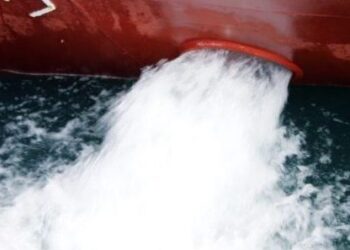Now convinced that the entry into force of the IMO Ballast Water Convention is imminent, Foreship explains how it can provide an independent assessment of the available ballast water management system retrofit options to assist owners.
The frequent addition of signatures to the 2004 International Convention for the Control and Management of Ships’ Ballast Water and Sediments in recent months cannot disguise the fact that this is an IMO measure resisted since conception. The 51 states which had signed up at IMO by June 2016 far exceed the 30 required but represent ‘only’ 34.87% of the 35% of world tonnage needed to trigger entry into force 12 months after ratification. The legal ‘instrument’ is closer than ever, but still not a done deal.
However, in 2016 owners are taking matters into their own hands, in the firm belief that technical answers are urgently needed on optimal BWMS performance for existing ships.

Olli Somerkallio, Foreship Head of Machinery Department, explains that while choosing between systems will certainly be guided by cost, comparisons can be less than straightforward.
“We have focused on the technical aspects of the installation, meaning space for equipment, piping connections and electrical compatibility,” says Somerkallio. “Expertise in naval architecture, marine engineering and ship behaviour are all needed to yield meaningful results.”
Ballast water flow rate requirements are typically below 500m3/h in the cruise ship sector have led owners to select BWMS technology based on UV, which makes invasive species ‘non-viable’ rather than killing them. As has been widely reported, however, definitive approval of UV testing criteria has not been forthcoming from the US Coast Guard.
Furthermore, UV installations are not practicable for the larger flow rates required by the main ballast water systems onboard large cargo ships, such as tankers and bulk carriers. Here, electro-chlorination (EC) has emerged as the preferred solution. EC produces chlorine-based disinfectants by running direct electrical current through water to cause a reaction with Sodium Chloride. The resulting free chlorine kills bacteria and other microbes in the ballast tanks. At the de-ballasting stage, chlorine content is measured and a neutralising agent introduced as necessary.
Special consideration must also be given to tankers, says Somerkallio, where ballast water operations occur both fore and aft, and aft ballast tanks are often over three quarters full – and so critical for unobstructed vessel operation. Here, the main ballast system pumps are located in the cargo pump room (hazardous area) and so cannot be used to pump water to the aft peak tank, which is in safe area. The aft pumps cannot be connected directly to the main BWMS.
A typical mid-range tanker could have main ballast system flow rate requirements of 2000 m3/h, split across port and starboard ballast tanks. This could be dealt with by two BWMS each with 1000m3/h capacity or a single BWMS where both pumps are connected to the same treatment system. Separate aft tank ballast water needs would be handled through the general service pumps, connected to a smaller BWMS with flow rates of 250-300m3/h (for example).
A recent Foreship feasibility study assessed two EC solutions from competing manufacturers in detail: one features EC in the main stream; in the other, EC occurs in a side stream, with the ‘chemical’ introduced to the ballast tanks.
Practically speaking, Somerkallio says, the mainstream system is less complex, lighter, smaller, and draws roughly 25% less electrical power than its sidestream counterpart. However, attributes related to installation, performance and safety an be persuasive in favour of a sidestream solution, he adds.
“For example, according to one manufacturer its mainstream EC system can operate in extremely low salinities due to special electrode design and materials, but operation in practically zero salinity waters such as the Great Lakes is not possible. No such restrictions apply to the sidestream system; if salinity is below 15 PSU, stored seawater can be used.”
The sidestream system is also better able to operate in colder water than its mainstream counterpart.
Again, there is no getting around the fact that the sidestream system could be twice the volume of its mainstream counterpart, also weighing 60% more, but Somerkallio points out it is more significant to ask where the additional BWMS is taking up space. He explains that a mainstream system forward requires a larger additional deckhouse for two EC units and two filters, while the smaller sidestream deckhouse solution brings greater positioning freedom for the EC unit and other auxiliaries.
In terms of footprint, a mainstream solution could require two thirds the area needed by a sidestream solution but, if a single sidestream system worked across two pumps, the difference would become almost negligible.
Similarly, the separation of the EC process required by the sidestream system demands twice as much piping as its mainstream counterpart. However, the majority of the extra pipes are of small diameter (DN20, DN40).
Somerkallio says that these variables confirm the need scrutiny at the level of individual ships, although he adds some general observations regarding tanker installations. Whatever the solution needed for the main system, the aft peak tanks need a different arrangement. A separate UV or EC system could be considered aft, but so could a ship-wide EC solution so long pump system separation between the main and aft systems was assured. In the latter case, the ‘chemical’ produced in the safe area would be distributed separately to the Aft Peak Tank system.
Somerkallio notes that EC systems of all types produce Hydrogen gas as a by-product, adding that here the sidestream option is definitively more risk averse: hydrogen can be extracted from the chlorine buffer tank with forced ventilation to trip the BWMS in case of ventilation failure.
As owners face up to the realities of retrofitting the technology, he suggests that Foreship’s detailed feasibility studies are revealing that any beauty in BWMS may be very firmly in the eye of the beholder.
Source & Image Credit: Foreship





























































